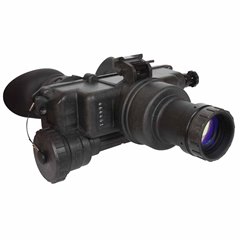Thermal imaging is in use across a myriad of professions, from the work with more direct linked uses such as firefighting and law enforcement to less obvious jobs. From contractors trying to improve heat efficiency in houses to electrical engineers pinpointing heat problems in wiring and circuitry, the practical uses of thermal imaging are spread across industries of all kinds.
 However, the actual products currently available on the thermal imaging market are often bulky, uncomfortable, and difficult to transport. Take this example, the PVS-7 Gen 3 night vision goggles from SightMark, a company that sells gun sights and thermal imaging equipment. “When I first came across these [kinds of] night vision devices, I said, ‘Wait a minute, these are basically clunky, oversized binoculars… I think I can build something more efficient and compact,’” recounts Alexander Sarris, founder of HeatSight.
However, the actual products currently available on the thermal imaging market are often bulky, uncomfortable, and difficult to transport. Take this example, the PVS-7 Gen 3 night vision goggles from SightMark, a company that sells gun sights and thermal imaging equipment. “When I first came across these [kinds of] night vision devices, I said, ‘Wait a minute, these are basically clunky, oversized binoculars… I think I can build something more efficient and compact,’” recounts Alexander Sarris, founder of HeatSight.
Alexander tells a story of a bored first-year college student at home for winter break who came across an article on the PopSci website about night vision and decided he could do it better. “I went to my dad’s workshop…discovered a dusty old night vision toy for kids in my closet, cannibalized it for parts, and eventually I had my first prototype, [cobbled] together with Scotch tape and some hot glue,” Alexander recalls.
***
Originally, HeatSight was never intended to be a startup at all. “I only really started working on night vision goggles because I had nothing to do over that winter break,” says Alexander. “My only thought was, ‘Hey, I like doing this, I’m going to keep working on it.’ So I kept building prototypes, and it just took on a life of its own after a while.”
HeatSight is focused on “developing compact thermal imaging goggles that are not only more compact, but more affordable than the products currently on the market,” in Alexander’s words. Returning again to the SightMark PVS-7 Gen 3 night vision goggles, one pair is currently going for $2,500 -- and that’s with a 30% discount off the normal price of almost $3,100. Alexander hopes to create a thermal imaging device that is “more like wearing a pair of normal [prescription] glasses than strapping a big machine on your face,” and one that won’t cost too much more than the average pair of prescription eyeglasses, either.
***
Alexander also shared a formative experience about how to make necessary adjustments or even scrap an idea altogether during the development process, painful as it may be. “A friend of mine was going to the library to get a movie on a Friday night, so I thought, ‘Great, I can test my goggles!’ I ended up almost falling down two different flights of stairs and ran straight into a wall at one point. I had a bunch of other upgrades in mind at the time… but it was that episode that made me realize I needed to go back to the drawing board and use a different type of night vision than the one I had been using.”
Looking ahead, Alexander says he is eager to learn more about how an entrepreneurial venture gets off the ground and does its day to day operations efficiently. “I really like working with hardware,” says Alexander, “but I know virtually nothing about creating and running a business, so I’m ready to work more on that front.”
As for advice to any aspiring entrepreneurs, Alexander did what he does best: optimize and simplify. “Your only limits are the ones you apply to yourself,” Alexander says decisively. “You’ll never know whether you can do something until you try.”
***
About the Founder
Alexander Sarris is an incoming graduate student at the University of Virginia. He received his B.S. in Electrical Engineering from the University of Virginia in 2018. Alexander has interned with the National Aeronautics and Space Administration (NASA) for two years, working on machine learning, website content analytics, website user interface and user exerperience (UI/UX), and data storage systems. Additionally, he has worked with Fortune 500 multinational engineering firm AECOM to design, build, and test innovative circuitry experiments and possible implementation. Alexander has most recently aided Northrop Grumman, the fifth largest defense contractor worldwide, testing functionality and feasibility of various radio, radar, and laser technologies.
Alexander can be found on LinkedIn here.
